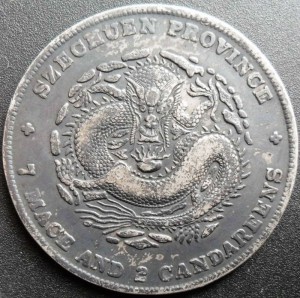Two weeks ago, I had the pleasure to travel back to the Szechuan province to pay an overdue visit to an old friend. Between enjoying the wonderful food in Nanchong and sipping tea by the Jialing river in Langzhong, I asked my friend to show me the antique market where the year before she had impulsively bought a lot of sixty fake coins. It was an excellent excuse for a stroll and I was curious to see if there would be anything genuine there. After walking through the crowded streets of the old Nanchong, we reached the market and went from shop to shop. There was indeed nothing of value, and I was ready to leave when a seller in a 旮旮旯旯 (pronounced kakagogo’r) corner of the market told me that he could show me interesting Chinese coins if I came back tomorrow.
Szechuan dollar Y-238 L&M 345 Doubled Die Obverse
The seller kept his word and indeed presented me genuine coins the next day. One of them caught my attention: it was one of the famous Szechuan three musketeers (四川三剑客). The Sān jiàn kè is a trio of rare and famous varieties of the Szechuan dollar, particularly coveted by Chinese coin collectors. These varieties are very difficult to find in good shape, some having been struck with badly duplicated dies, like the one I just found.
The coin I had in front of me was a 剑毛龙 (sharp spines dragon), with a misshapen 庫 character on the reverse: the top of the vertical stroke of 車, which normally should connect to the 广, was missing. The full name of this rare variety: “Sharp Spines Dragon, with a decapitated Chē and a rosette with dot” (剑毛龙无头车(花心带点)) sounds like a dish from a French restaurant menu but it is necessary to precisely identify this particular type amongst more than two hundred recensed varieties of the Szechuan dollar.
This variety is famous for the doubling of the English legend, especially on the word PROVINCE. The weak strike on the dragon scales and right eye are also normal for this particular type, most likely from trying to duplicate an already damaged die. If we had to draw a parallel with the Three Musketeers from Alexandre Dumas, this dragon burdened with a doubled die may be Aramis, struggling to reconcile the double life of an aspiring abbot become soldier…
The 7 Mace and 3 Candareens error Szechuan dollar
The coin I got in Nanchong is only second in rarity to the 7 mace and 3 candareens Szechuan dollar. That error coin is very hard to obtain in good condition, with most specimen available only in VF grade or less. The Chinese name of the variety is 尖角龙七三误书, or Pointed Horns Dragon with 7.3 lettering error. Despite its stated weight of 7 mace and 3 candareens in English on the obverse, the coin has a Chinese face value of 7 mace and 2 candareens, and a regular size and weight, contrary to the early Kwang-Tung dollar of same denomination that actually had a higher silver content. This rare error coin is affectuously called 三剑客老大 by Szechuan dollar collectors: the beloved elder of the Szechuan three Musketeers. I guess this rare and fierce dragon could be compared to Athos, the stern fatherly figure which is also the last to make its appearance in the book.
Szechuan dollar Y-243 L&M 352
The third musketeer is conversely the easiest to find of the trio. Called 大折金珍珠龙 in Chinese, or Pearl-scaled dragon with Crooked Gold, its particularity resides in the bold bottom stroke of the 金 part of the character 錢, which features an extravagant hook.
The Pearl-scaled dragon is one of the most beautiful varieties of the Szechuan dollar: most collectors will only seek it in higher grade, with all its scales still visible (全龙鳞), rejecting lesser condition coins (somewhat harshly called 垃圾龙, dragon-trash). Porthos, the elegant musketeer from Dumas’ epic, would likely have most fancied this last variety.







